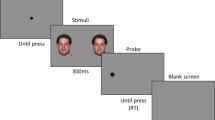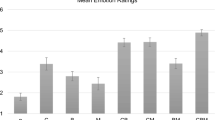Abstract
Emotional facial expressions provide critical information for social interactions. Above all, angry faces are assumed to reflect potential social threat. We investigated event-related potentials (ERPs) triggered by natural and artificial faces expressing fear, anger, happiness or no emotion in participants with low and high levels of social anxiety. Overall, artificial faces elicited stronger P100 and N170 responses than natural faces. Additionally, the N170 component was larger for emotional compared to neutral facial expressions. Social anxiety was associated with an enhanced emotional modulation of the early posterior negativity (EPN) in response to fearful and angry facial expressions. Additionally, while the late positive potential (LPP) was larger for emotional than for neutral faces in low socially anxious participants, LPPs of higher socially anxious participants did not differ. LPPs might therefore be enhanced in higher socially anxious participants for both emotional and neutral faces. Furthermore, the modulations of the EPN and LPP were comparable between natural and artificial faces. These results indicate that social anxiety influences early perceptual processing of faces and that artificial faces are suitable for psychophysiological emotion research.



Similar content being viewed by others
Notes
The German scores of the Social Phobia and Anxiety Inventory (SPAI) were transformed into the original scores (Turner et al. 1989).
References
Amir N, Klumpp H, Elias J et al (2005) Increased activation of the anterior cingulate cortex during processing of disgust faces in individuals with social phobia. Biol Psychiatry 57:975–981
Amrhein C, Pauli P, Mühlberger A et al (2004) Modulation of event-related brain potentials during affective picture processing: a complement to startle reflex and skin conductance response? Int J Psychophysiol 54:231–240
Balconi M, Lucchiari C (2005) Event-related potentials related to normal and morphed emotional faces. J Psychol 139:176–192
Balconi M, Pozzoli U (2003) Face-selective processing and the effect of pleasant and unpleasant emotional expressions on ERP correlates. Int J Psychophysiol 49:67–74
Batty M, Taylor MJ (2003) Early processing of the six basic facial emotional expressions. Cogn Brain Res 17:613–620
Bentin S, Allison T, Puce A et al (1996) Electrophysiological studies of face perception in humans. J Cogn Neurosci 8:551–565
Birbaumer N, Grodd W, Diedrich O et al (1998) fMRI reveals amygdala activation to human faces in social phobics. Neuroreport 9:1223–1226
Blau V, Maurer U, Tottenham N et al (2007) The face-specific N170 component is modulated by emotional facial expression. Behav Brain Funct 3:7
Bradley MM (2000) Êmotion and motivation. In: Cacioppo JT, Tassinary LG, Berntson G (eds) Handbook of psychophysiology. Cambridge University Press, New York
Bradley MM, Codispoti M, Sabatinelli D et al (2001) Emotion and motivation II: sex differences in picture processing. Emotion 1:300–319
Caharel S, Poiroux S, Bernard C et al (2002) ERPs associated with familiarity and degree of familiarity during face recognition. Int J Neurosci 112:1499–1512
Caharel S, Courtay N, Bernard C et al (2005) Familiarity and emotional expression influence an early stage of face processing: an electrophysiological study. Brain Cogn 59:96–100
Cuthbert BN, Schupp HT, Bradley MM et al (2000) Brain potentials in affective picture processing: covariation with autonomic arousal and affective report. Biol Psychol 52:95–111
Dimberg U, Petterson M (2000) Facial reactions to happy and angry facial expressions: evidence for right hemisphere dominance. Psychophysiology 37:693–696
Dimberg U, Thunberg M (1998) Rapid facial reactions to emotional facial expressions. Scand J Psychol 39:39–45
Dimberg U, Thunberg M, Elmehed K (2000) Unconscious facial reactions to emotional facial expressions. Psychol Sci 11:86–89
Donchin E, Coles MG (1988) Is the P300 component a manifestation of context updating? Behav Brain Sci 11:357–427
Eimer M (1998) Does the face-specific N170 component reflect the activity of a specialized eye processor? Neuroreport 9:2945–2948
Eimer M (2000) The face-specific N170 component reflects late stages in the structural encoding of faces. Neuroreport 11:2319–2324
Eimer M, Holmes A (2002) An ERP study on the time course of emotional face processing. Neuroreport 13:427–431
Eimer M, Holmes A (2007) Event-related brain potential correlates of emotional face processing. Neuropsychologia 45:15–31
Ekman P (2003) Emotions revealed. Henry Holt, New York
Ekman P, Friesen W-V (1975) Unmasking the face: a guide to recognizing emotions from facial clues. Prentice Hall, Englewood Cliffs
Ekman P, Friesen WV (1976) Pictures of facial affect. Consulting Psychologists Press, Palo Alto
Ekman P, Friesen WV (1978) Facial action coding system: investigator’s guide Part I. Consulting Psychologist Press, Palo Alto
Esteves F (1994) Automatically elicited fear: conditioned skin conductance responses to masked facial expressions. Cogn Emot 8:393–413
Fink B, Penton-Voak I (2002) Evolutionary psychology of facial attractiveness. Curr Dir Psychol Sci 11:154–158
Fox E, Lester V, Russo R et al (2000) Facial expressions of emotion: are angry faces detected more efficiently? Cogn Emot 14:61–92
Fydrich T (2002) SPAI—Soziale Phobie und Angst Inventar. In: Brähler E, Schumacher J, Strauß B (eds) Diagnostische Verfahren in der Psychotherapie. Hogrefe, Göttingen
Gratton G, Coles MG, Donchin E (1983) A new method for off-line removal of ocular artifact. Electroencephalogr Clin Neurophysiol 55:468–484
Halgren E, Raij T, Marinkovic K et al (2000) Cognitive response profile of the human fusiform face area as determined by MEG. Cereb Cortex 10:69–81
Halit H, de Haan M, Johnson MH (2000) Modulation of event-related potentials by prototypical and atypical faces. Neuroreport 11:1871–1875
Herrmann MJ, Aranda D, Ellgring H et al (2002) Face-specific event-related potential in humans is independent from facial expression. Int J Psychophysiol 45:241–244
Holmes A, Vuilleumier P, Eimer M (2003) The processing of emotional facial expression is gated by spatial attention: evidence from event-related brain potentials. Cogn Brain Res 16:174–184
Holmes A, Nielsen MK, Green S (2008) Effects of anxiety on the processing of fearful and happy faces: an event-related potential study. Biol Psychol 77:159–173
Ito TA, Urland GR (2005) The influence of processing objectives on the perception of faces: an ERP study of race and gender perception. Cogn Affect Behav Neurosci 5:21–36
Izard CE (1994) Innate and universal facial expressions: evidence from developmental and cross-cultural research. Psychol Bull 115:288–299
Johnston VS (2006) Mate choice decisions: the role of facial beauty. Trends Cogn Sci 10:9–13
Junghöfer M, Bradley MM, Elbert TR et al (2001) Fleeting images: a new look at early emotion discrimination. Psychophysiology 38:175–178
Kanwisher N, McDermott J, Chun MM (1997) The fusiform face area: a module in human extrastriate cortex specialized for face perception. J Neurosci 17:4302–4311
Kolassa I-T, Miltner WHR (2006) Psychophysiological correlates of face processing in social phobia. Brain Res 1118:130–141
Kolassa I-T, Kolassa S, Musial F et al (2007) Event-related potentials to schematic faces in social phobia. Cogn Emot 21:1721–1744
Krolak-Salmon P, Fischer C, Vighetto A et al (2001) Processing of facial emotional expression: spatio-temporal data as assessed by scalp event related potentials. Eur J Neurosci 13:987–994
Lang PJ, Bradley MM, Cuthbert BN (1997) Motivated attention: affect, activation, and action. In: Lang PJ, Simons RF, Balaban MT, Lang PJ, Simons RF, Balaban MTs (eds) Attention and orienting: sensory and motivational processes. Erlbaum, Mahwah, pp 97–135
Laux L, Glanzmann P, Schaffner P et al (1981) Das State-Trait-Angstinventar. Beltz Test, Weinheim
Leary MR (1983) A brief version of the fear of negative evaluation scale. Pers Soc Psychol Bull 9:371–375
Lundqvist D, Flykt A, Öhman A (1998) Karolinska directed emotional faces (KDEF). Karolinska Institutet, Stockholm
Moser JS, Duval E, Simons RF (2006) Fried, foe, or I don’t know? Electrophysiologcial evidence of enhanced processing of neutral facial expressions in social phobia. Psychophysiology 43:S69
Moser E, Derntl B, Robinson S et al (2007) Amygdala activation at 3T in response to human and avatar facial expressions of emotions. J Neurosci Methods 161:126–133
Moser JS, Huppert JD, Duval E et al (2008) Face processing biases in social anxiety: an electrophysiological study. Biol Psychol 78:93–103
Münte TF, Brack M, Grootheer O et al (1998) Brain potentials reveal the timing of face identity and expression judgments. Neurosci Res 30:25–34
Öhman A (1986) Face the beast and fear the face: animal and social fears as prototypes for evolutionary analyses of emotion. Psychophysiology 23:123–145
Öhman A, Mineka S (2001) Fears, phobias, and preparedness: toward an evolved module of fear and fear learning. Psychol Rev 108:483–522
Öhman A, Lundqvist D, Esteves F (2001) The face in the crowd revisited: a threat advantage with schematic stimuli. J Pers Soc Psychol 80:381–396
Oliver-Rodriguez JC, Guan Z, Johnston VS (1999) Gender differences in late positive components evoked by human faces. Psychophysiology 36:176–185
Orozco S, Ehlers CL (1998) Gender differences in electrophysiological responses to facial stimuli. Biol Psychiatry 44:281–289
Pizzagalli D, Lehmann D, Koenig T et al (2000) Face-elicited ERPs and affective attitude: brain electric microstate and tomography analyses. Clin Neurophysiol 111:521–531
Rossignol M, Philippot P, Douilliez C et al (2005) The perception of fearful and happy facial expression is modulated by anxiety: an event-related potential study. Neurosci Lett 377:115–120
Sabatinelli DCA, Flaisch T, Bradley MM et al (2004) Affective picture perception: gender differences in visual cortex? Neuroreport 15:1109–1112
Sagiv N, Bentin S (2001) Structural encoding of human and schematic faces: holistic and part-based processes. J Cogn Neurosci 13:937–951
Sato W, Kochiyama T, Yoshikawa S et al (2001) Emotional expression boosts early visual processing of the face: ERP recording and its decomposition by independent component analysis. Neuroreport 12:709–714
Schupp HT, Cuthbert BN, Bradley MM et al (2000) Affective picture processing: the late positive potential is modulated by motivational relevance. Psychophysiology 37:257–261
Schupp HT, Junghoefer M, Weike AI et al (2003) Emotional facilitation of sensory processing in the visual cortex. Psychol Sci 14:7–13
Schupp HT, Junghofer M, Weike AI et al (2004a) The selective processing of briefly presented affective pictures: an ERP analysis. Psychophysiology 41:441–449
Schupp HT, Ohman A, Junghofer M et al (2004b) The facilitated processing of threatening faces: an ERP analysis. Emotion 4:189–200
Schutter DJ, de Haan EH, van Honk J (2004) Functionally dissociated aspects in anterior and posterior electrocortical processing of facial threat. Int J Psychophysiol 53:29–36
Somerville LH, Whalen PJ (2006) Prior experience as a stimulus category confound: an example using facial expressions of emotion. Soc Cogn Affect Neurosci 1:271–274
Spencer-Smith J, Wild H, Innes-Ker AH et al (2001) Making faces: creating three-dimensional parameterized models of facial expression. Behav Res Methods Instrum Comput 33:115–123
Spielberger CD, Gorsuch RL, Lushene RE (1970) State-trait anxiety inventory. Consulting Psychologists Press, Palo Alto
Straube T, Mentzel HJ, Miltner WHR (2005) Common and distinct brain activation to threat and safety signals in social phobia. Neuropsychobiology 52:163–168
Tipples J, Atkinson AP, Young AW (2002) The eyebrow frown: a salient social signal. Emotion 2:288–296
Turk CL, Heimberg RG, Orsillo SM et al (1998) An investigation of gender differences in social phobia. J Anxiety Disord 12:209–223
Turner SM, Beidel DC, Dancu CV et al (1989) An empirically derived inventory to measure social fears and anxiety: the Social Phobia and Anxiety Inventory (SPAI). Psychol Assess 1:35–40
Veit R, Flor H, Erb M et al (2002) Brain circuits involved in emotional learning in antisocial behavior and social phobia in humans. Neurosci Lett 328:233–236
Walker Smith GJ, Gale AG, Findlay JM (1977) Eye movement strategies involved in face perception. Perception 6:313–326
Watson D, Clark LA, Tellegen A (1988) Development and validation of brief measures of positive and negative affect: the PANAS Scales. J Pers Soc Psychol 54:1063–1070
Weyers P, Mühlberger A, Hefele C et al (2006) Electromyographic responses to static and dynamic avatar emotional facial expressions. Psychophysiology 43:450–453
Williams LM, Palmer D, Liddell BJ et al (2006) The `when’ and `where’ of perceiving signals of threat versus non-threat. Neuroimage 31:458–467
Yoon KL, Zinbarg RE (2007) Threat is in the eye of the beholder: social anxiety and the interpretation of ambiguous facial expressions. Behav Res Ther 45:839–847
Acknowledgments
This research was supported by the German Research Foundation (MU2299/1-2). The authors would like to thank M. Müller for excellent technical assistance.
Author information
Authors and Affiliations
Corresponding author
Additional information
Dedicated to the special issue on anxiety.
Rights and permissions
About this article
Cite this article
Mühlberger, A., Wieser, M.J., Herrmann, M.J. et al. Early cortical processing of natural and artificial emotional faces differs between lower and higher socially anxious persons. J Neural Transm 116, 735–746 (2009). https://doi.org/10.1007/s00702-008-0108-6
Received:
Accepted:
Published:
Issue Date:
DOI: https://doi.org/10.1007/s00702-008-0108-6




